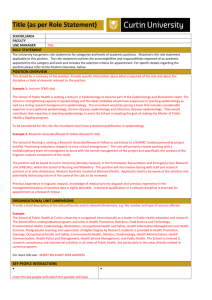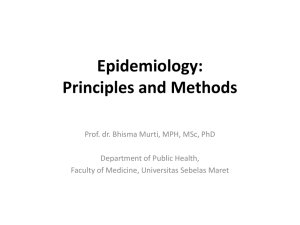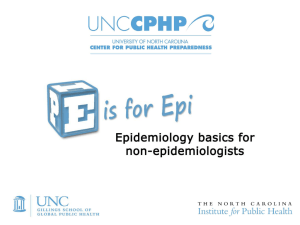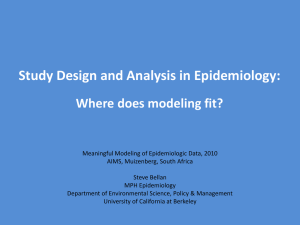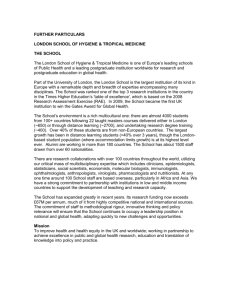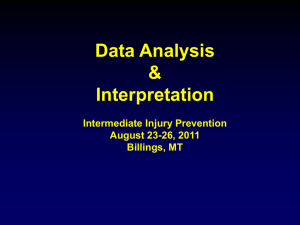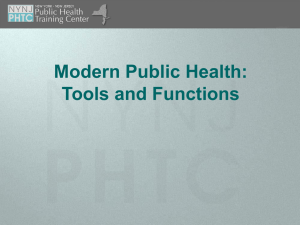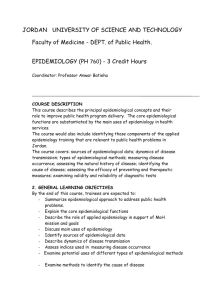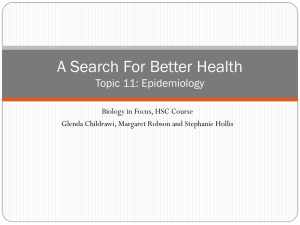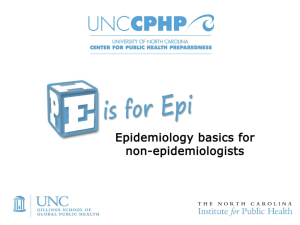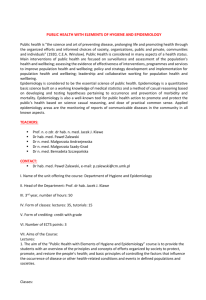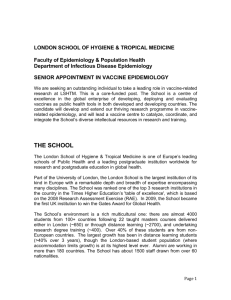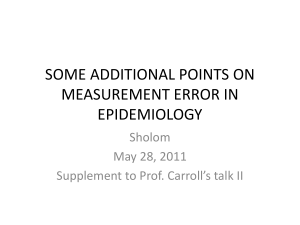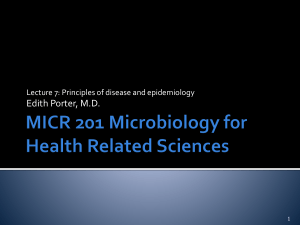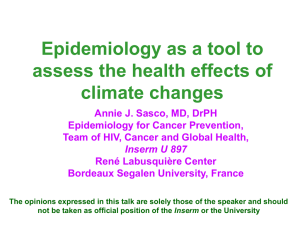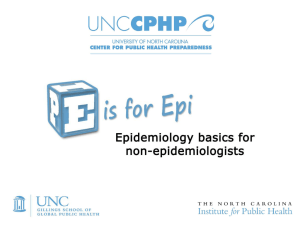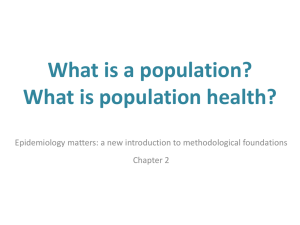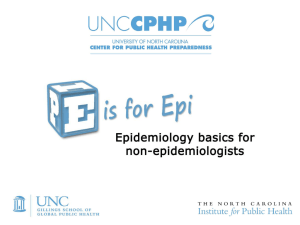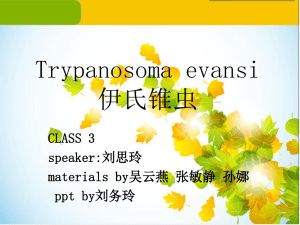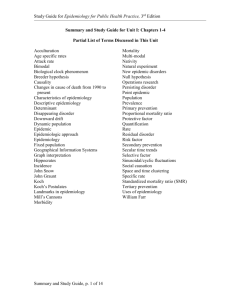Applied Epidemiology
advertisement
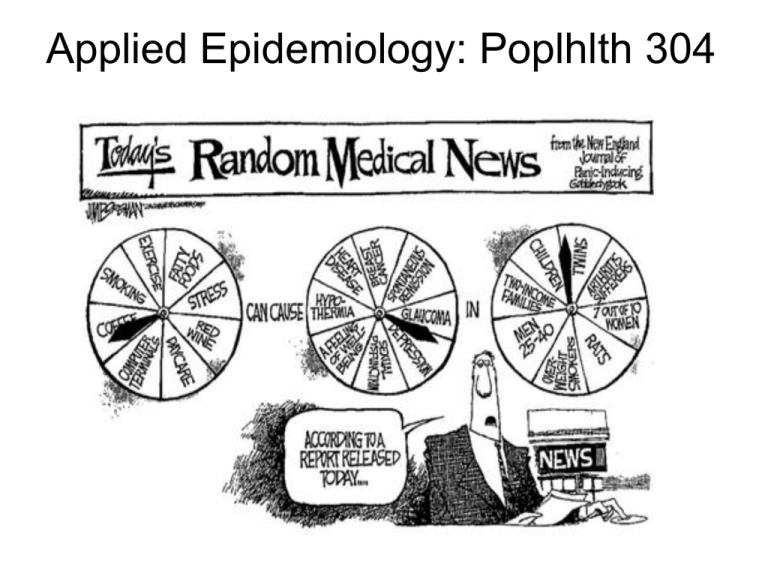
Applied Epidemiology: Poplhlth 304
{
Simon Thornley
Course co-ordinator
and PhD candidate
Staff
{
Josh Knight
Tutor and PhD
candidate
Epidemiology can take you places...
http://gameauland.com/thatsugar-film-teaser/
Outline
Introductions
Why study epidemiology?
My story
Course outline
Assessment :-(
Introductions
A bit about you...
Pairs, 5 mins; report back one thing about the person that
stands out and why they are interested in a career in health.
A bit about me...
Lectures and course material made available at...
http://flexiblelearning.auckland.ac.nz/poplhlth304/
Also on CECIL
My career
Why?
What is epidemiology?
What is epidemiology?
“The study of the distribution and determinants of health related
states or events in specified populations, and the application of
this study to control health problems”
Detective work
Who gets sick and why?
Once we've found out why, what can we do about it?
Sounds simple, but many fish hooks
Many reasons it goes wrong
“Wrong”, by Freedman
Our girth is expanding
Why?
Do some numbers help?
1980 1990
2000
Switzerland
UK
US
NZ
Portugal
Slovakia
Obesity %(BMI>30kg/m2)
30
25
20
15
10
5
Spain
Sweden
30
25
20
15
10
5
Italy
Japan
Korea
Netherlands
Norway
Finland
France
Germany
Hungary
Ireland
30
25
20
15
10
5
30
25
20
15
10
5
Australia
Austria
Canada
Czech
Denmark
30
25
20
15
10
5
1980 1990 2000
1980
1990 2000
Year
1980 1990
2000
Asthma
What causes asthma?
Culprit?
Is sugar a confounder?
What epidemiology isn't
Statistics
Health promotion
Easy, requires effort
Static, rather constantly evolving
Why study epidemiology?
Skills are transferable to any subject
Mercury on cognitive development?
How smoking cessation drugs work?
Who gets CVD?
Why cyclists crash?
Effect of alcohol on injury?
Smoking policy in prisons?
Who gets gout and diabetes?
Find out what is working and what is not
Stop wasting money, do no harm
What we will cover?
Practical aspects of analytical epidemiology
Understand different study designs
Analysis of data using statistical software
(R commander).
Health and social progress
The course in a nutshell
Epidemiology in a nutshell
Aim
• does exposure cause
disease?
• does drug treat disease?
Is change in exposure distribution
temporally related with change in
disease distribution?
Statistical power calculation (type-1, type-2
error, prevalence of disease in unexposed,
minimum detectable effect)
Design study
Can I randomise?
• Ethical?
• Clinical equipoise?
Yes
Randomised study
Report (RR)
No?
Observational
study
Rare
Exposure? Many
outcomes?
Cohort
(report RR)
Rare disease?
One outcome?
Case-control
(report OR)
Define case and
exposure status
Table 1
Check missing data, duplicates, data range, bivariate scatterplots and lowess
curves
Are there systematic
differences between
exposure and
unexposed groups
(confounding)
Yes (shouldn’t be in
RCT!)
Are they adjusted for
in the analysis if
confounders?
Population divided by
exposure status?
What population is
the study sample
drawn from?
Is it representative of
underlying
population or is there
likely selection bias?
Results: Analysis
Check data distributions
Transform?
Outcome variable?
Continuous
t-test
Categorical
Report ‘crude’ or
univariate measures
of association
(OR/RR/HR)
Chi-square or
Fisher exact test if cell
counts <5
Confounders? Review scientific literature… is there likely to be a
• “Shared common cause of exposure and disease”?
Multiple linear
regression
If difference between crude and
adjusted >10%, then
Statistical evidence of
confounding
Logistic regression
and or stratification
Report adjusted
measures of
association (OR/RR)
Interpret study results
Estimate OR/RR and
95% C. I.
Is there an association
between exposure and
outcome?
Is P <0.05 or 95% CI
for measure of
association contain
null value (1)?
Yes
Exposure is associated with disease
No
Hypothesis
likely false
Consider type-2
error;
confounding,
bias, other studies
Is there another
explanation?
Bias
Information
(recall)
Selection
(survivor; loss to follow up, hosp.
controls)
Could study design be
improved?
Confounding
Shared common cause
of exposure and
disease?
Regression or
stratified analysis
Type-1 error
(consider strength of
association)
How does my study
compare with others?
Discussion
Is the association I have
detected causal?
Bradford Hill criteria
Temporality: (cohort study? Not cross sectional or case-control which do not separate
exposure and disease)
Strength of association: (odds ratio or relative risk, does it indicate >50% increase)
Dose response: is there increasing association with increased exposure?
Biological plausibility: (are there any laboratory studies to support your assertions?)
Consistency: (do other studies using different methods, with different groups come up
with similar findings?)
Experimental evidence: (Any randomised studies?)
Analogy: (Any similar findings from related fields of science?)
Specificity: Is exposure to the cause reliably followed by disease?
Also: are there any other competing explanations? Are there any studies which shed
light on these? If not then…
Yes (on balance)
Exposure causes disease
Calculate Risk difference, NNT and
PPAR.
Textbook
Designing Clinical Research. Hulley, SB. Lippincott, 3rd edition.
Alternatives available (from library) Many free e-books available.
A Pocket Guide to Epidemiology. David G. Kleinbaum, Kevin M.
Sullivan, Nancy D. Barker. 2007, Springer.
Lecture outline
First 3 weeks – Basic epidemiology, study design, effect measures
Weeks 3 to 6 – Error in epidemiology and its remedies; bias,
confounding, measurement error
Weeks 7 to 11 – Application of epidemiology; Asthma, vitamin D,
CVD risk prediction, ethics, grants.
Assessment
3 Assignments:
Assignment 1 – 10%
Due by 4pm Wednesday 19th March 2014
Assignment 2 – 10%
Due by 4pm Wednesday 9th April 2014
Assignment 3 – 30%
Due by 4pm Wednesday 21st May 2014
Final exam – 50%
Principles and application
We use epidemiology every day without thinking about
it...
A story... me as a medical student
Epidemiology
Start with belief (does she like me?)
Collect data (does she want to spend time with me? If
so, how often)
Analyse and interpret data....
Which hypothesis is most likely after
collecting the data?
She does or she doesn't like me...
Consider other data... “does she like someone else?”
Action
Proposal?
Happy ending...
Questions?
?

